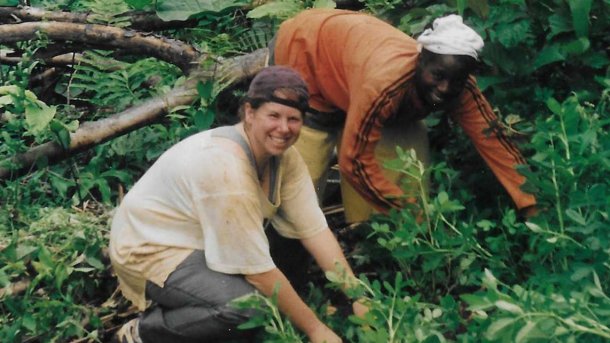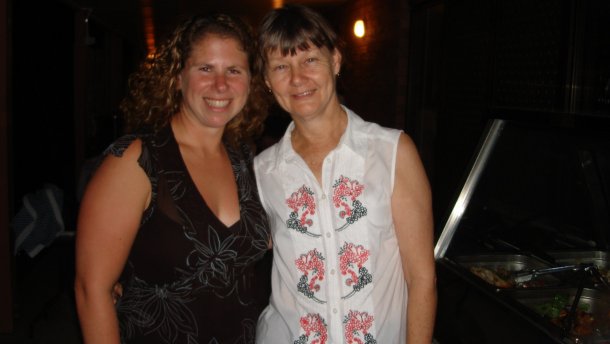This piece comes to us from the Wildlife Conservation Society (WCS). To honor Women’s History Month, WCS and Nature are bringing you stories of women in the fields of nature and conservation.
When I was twelve years old, I announced to my family that I intended to become a marine biologist. We didn’t live next to the ocean in the suburbs west of Boston, so I don’t think anyone took me that seriously. I had recently finished reading “The Arm of the Starfish” by Madeleine L’Engle, which had marine biologists as central characters and ignited my already curious interest in the natural world.
But how does one become a marine biologist? Much to my consternation, there was no handy playbook. Meanwhile, there were much clearer roadmaps to “sensible” career pathways in medicine, law or business. For my family, marine biology was the stuff of comedy, recalling the Seinfeld episode in which George describes how he pulled out a golf ball obstructing the blowhole of a “great fish.” That famous episode aired as I was completing my first year as a biology major at Harvard University.
While my family kept waiting for me to take the Medical College Admission Test (MCAT) in expectation of following my father’s footsteps as a doctor, I searched for an entry into any field resembling marine biology. Learning that my high school AP efforts would enable me to graduate in three years of coursework, I looked to fill the gap by following my marine biology passions.

The author surveying coral reefs in Fiji. Photo credit: © Emily Darling.
At Duke’s Marine Laboratory in Beaufort, North Carolina, I learned to SCUBA dive, and got a taste for what marine mammal work might be like when volunteering one night to sponge-bathe a stranded dolphin. From there, I ventured across the Pacific Ocean to the University of Sydney, Australia, where Professor Maria Byrne agreed to take me on as a lab volunteer.
I was excited to meet a real life marine biologist who seemed sprung from the pages of the classic Madeleine L’Engle novel. Maria was a dynamo, running a lab and large research program, teaching a full course load, while also looking after two small children. I thought, “I want to be just like her.” Maria guided me to write my first scientific paper, on freshwater mussels. It was published in my senior year in college.
Following graduation, I joined the Peace Corps. During my interview, I told my recruiter about my great vision for becoming a marine biologist and working with reef fisheries, which ended up translating to a posting as a Rural Fisheries Extension Agent in Gabon in Central Africa. I was stuck upstream and stuck in the mud, biking everyday as far as 40 kilometers between remote villages.

Stacy Jupiter as a Peace Corps Volunteer in rural Gabon, circa 1998. Photo courtesy of the author.
During the rainy seasons in Gabon, the rain came in torrents, swelling rainforest creeks and streams that quickly filled with the red clay mud from the road and nearby plantations. It was during this time that I started wondering about where all of that mud went, a question I dove into for my doctoral dissertation through the University of California, Santa Cruz, as well as at the University of Queensland while on a Fulbright scholarship.
My research aimed to investigate how historical land clearing for agriculture changed the amount of sediments reaching the nearshore Great Barrier Reef. While the ultimate aim of the research was to understand the impacts on the coral reef itself, I spent the majority of my time in the field still stuck in the mud—either upstream in the watershed taking water quality samples or downstream in the mangroves figuring out how the mud changed the shape of an estuary.
I was aided in my work by one particularly generous individual, who cared enough about the environment to offer me a place to stay and some lovely meals in exchange for the occasional assistance I could provide pulling out invasive lantana from her property and using my artistic skills to support local conservation efforts. Maureen Cooper became like a second mother and inspired me with her work to return wildlife to sugarcane fields restored to native bushland.

Stacy Jupiter and Maureen Cooper at Padaminka Nature Refuge in Walkerston, Queensland in 2006. Photo courtesy of the author.
My experience looking at the connections from ridge to reef in Australia ultimately led to a position with the Wildlife Conservation Society (WCS) in Fiji. Fiji contains about a third of all coral reef area in the southwest Pacific. In my roles over the past 16 years as WCS Fiji country program head, and then Melanesia Regional Director, I have been lucky to see my fair share of them. Investigating coral reef health, I’ve learned so much about the sensitivity of these fragile systems to global climate change and their response to local management.
As the newly appointed Executive Director of WCS’s Global Marine program, I am ready to take on new challenges in supporting our teams around the world to develop innovative and equitable approaches to ocean conservation in tropical, temperate, and polar regions. And like the women who inspired me, I am also ready to support the next generation of marine biologists, particularly young women whom I can mentor to become future champions of ocean conservation.
